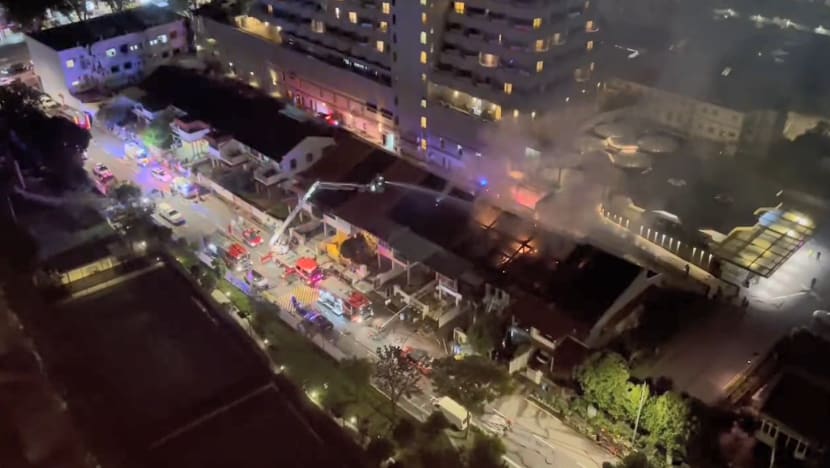Pit cover of nearest fire hydrant in East Coast blaze was initially stuck: SCDF

The aftermath of a fire that broke out along East Coast Road. (Photo: CNA reader)
SINGAPORE: The pit cover of the nearest fire hydrant during a blaze at East Coast Road earlier this week was stuck, and attempts to dislodge it were unsuccessful at first, the Singapore Civil Defence Force (SCDF) said on Friday (Jan 13).
The statement came after a video on TikTok emerged, alleging that firefighters struggled to connect a water hose to a fire hydrant. The clip also showed the water from the hose being unable to reach the fire, allegedly due to insufficient water pressure.
In response to media queries, an SCDF spokesperson said it was alerted to the fire on Monday at 11.50pm. A Light Fire Attack Vehicle (LFAV) arrived at the scene within six minutes.
“The fire was observed to be well alight at two of the units and was threatening to spread to two adjacent units via the roof,” the spokesperson said.
The LFAV crew immediately proceeded to the nearest hydrant to set up the water supply, which was needed to operate the LFAV’s water monitor.
Meanwhile, a fire engine arrived at around 11.57pm, and firefighting operations soon commenced with two water jets drawing water from the fire engine’s internal tank.
Said the SCDF spokesperson: "The pit cover of the nearest hydrant that the LFAV crew had attempted to use was stuck and attempts to dislodge it were initially unsuccessful."
According to SCDF, the last operational test on the hydrant with the stuck pit cover was in December 2021, during which it was found to be in proper working condition. It would have been tested again this March.
A fire engine carries enough water to immediately support firefighting operations for at least about 10 minutes before replenishment is needed, the spokesperson added.
An assessment was then made to use the next nearest hydrant, which was “standard procedure”. Water supply from the hydrant, which was about 100m from the affected units, was established at about 12.06am.
“While a water supply hose from that hydrant was initially channelled to the LFAV’s water monitor, a decision was made to quickly redirect it to the fire engine’s water tank, which was necessary to ensure that there was no water disruption to the two water jets,” the spokesman said.
“This was to enable uninterrupted firefighting efforts with the first two water jets.”
At around 12.11am, subsequent arriving resources were deployed to the rear of the affected units to support the firefighting operation. Two additional fire hydrants, which were located in the vicinity, were used to supply water to these resources.
“At this point, the fire was well developed and had spread to a total of four units,” the spokesperson said.
The pit cover of the first fire hydrant was eventually dislodged after another attempt at around 12.35am. Water was immediately tapped from it to support the firefighting operations.
“With a total of four hydrants supplying water for the firefighting efforts, the strategy was to surround and contain the fire to the affected units,” the spokesperson said.
“This included the deployment of an aerial water jet from the Combined Platform Ladder which helped to limit the spread of the fire and minimise the damage to neighbouring units.”
The fires were brought under control at around 12.40am, about 45 minutes after SCDF’s arrival. Water jets were then deployed into the affected units to fully extinguish the fires.
A total of 15 emergency vehicles, 60 officers and six water jets – including the aerial water jet from the Combined Platform Ladder – were deployed in the operation.
SCDF extinguished the fires in about two hours.
One person was assessed by a paramedic for a minor burn injury and taken to Singapore General Hospital. About 20 residents were also evacuated.
According to preliminary investigations, the fire started from a bedroom on the second level of one of the units. Further investigations are ongoing to determine the cause.
On Wednesday, water agency PUB said that it carried out on-site checks the morning after the fire, and found the fire hydrants in the vicinity to be in working order.
It also said there was sufficient water pressure within its supply network to support SCDF operations.
During a fire at Henderson Road last month, a fire engine accessway leading to the affected unit was blocked by a funeral wake tent, leading to an 18-minute delay in firefighters' response to the blaze.
Officers had to remove the bollards that were padlocked to the ground near the tent to create an access path.
The contractor responsible for putting up the funeral wake tent was issued a summons by Tanjong Pagar Town Council.














